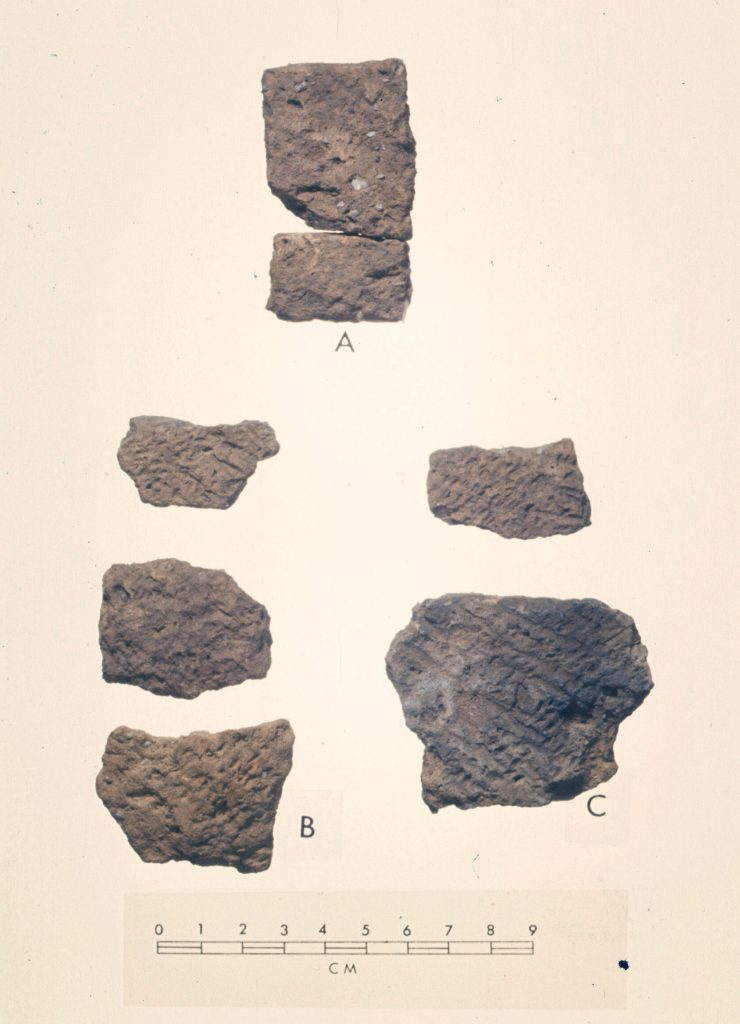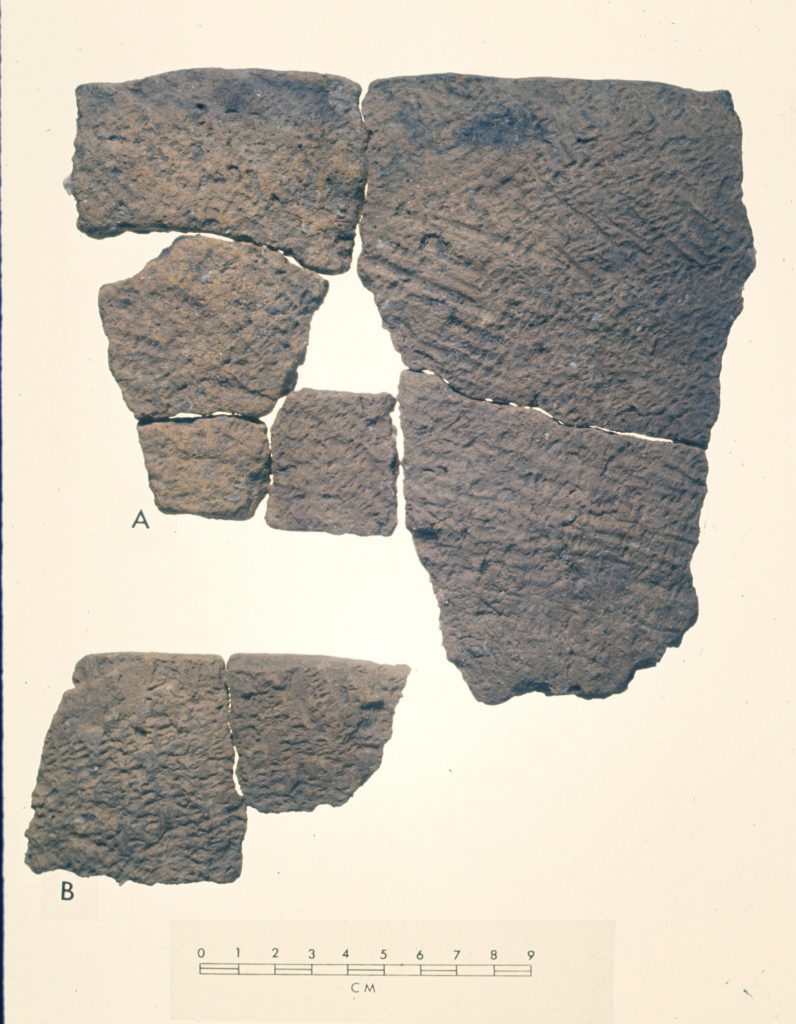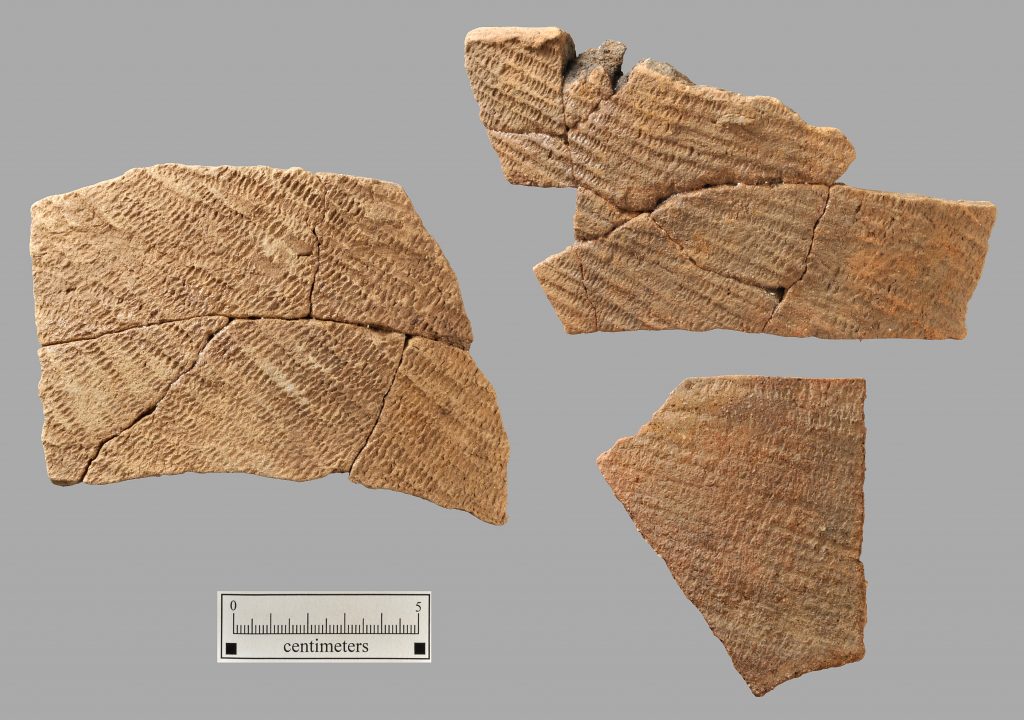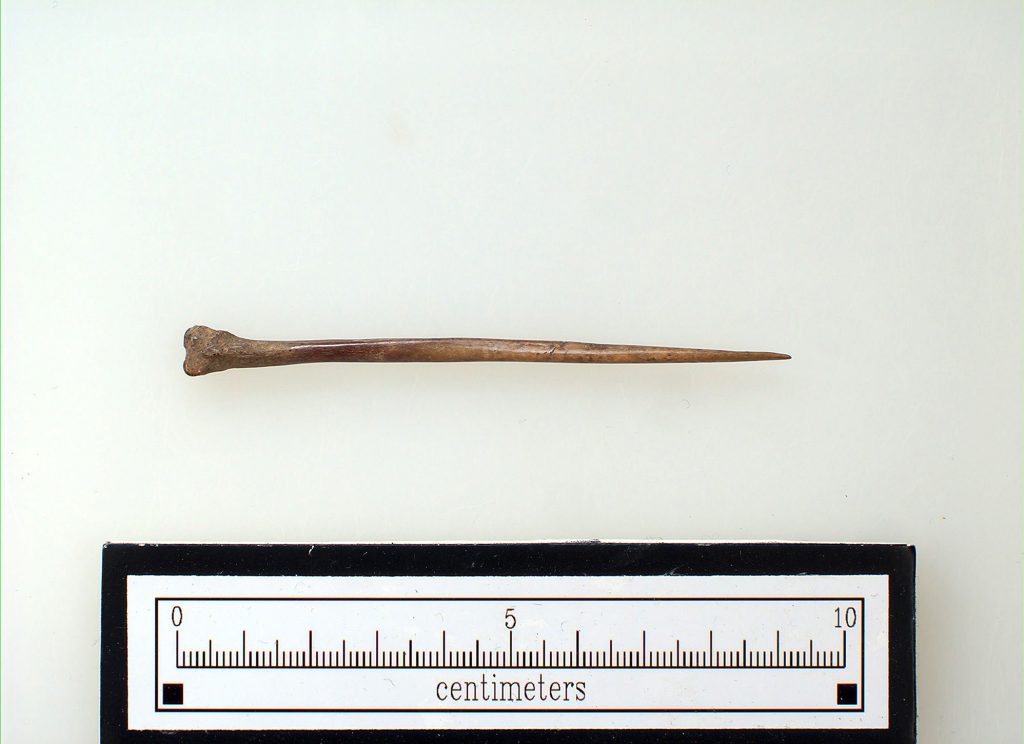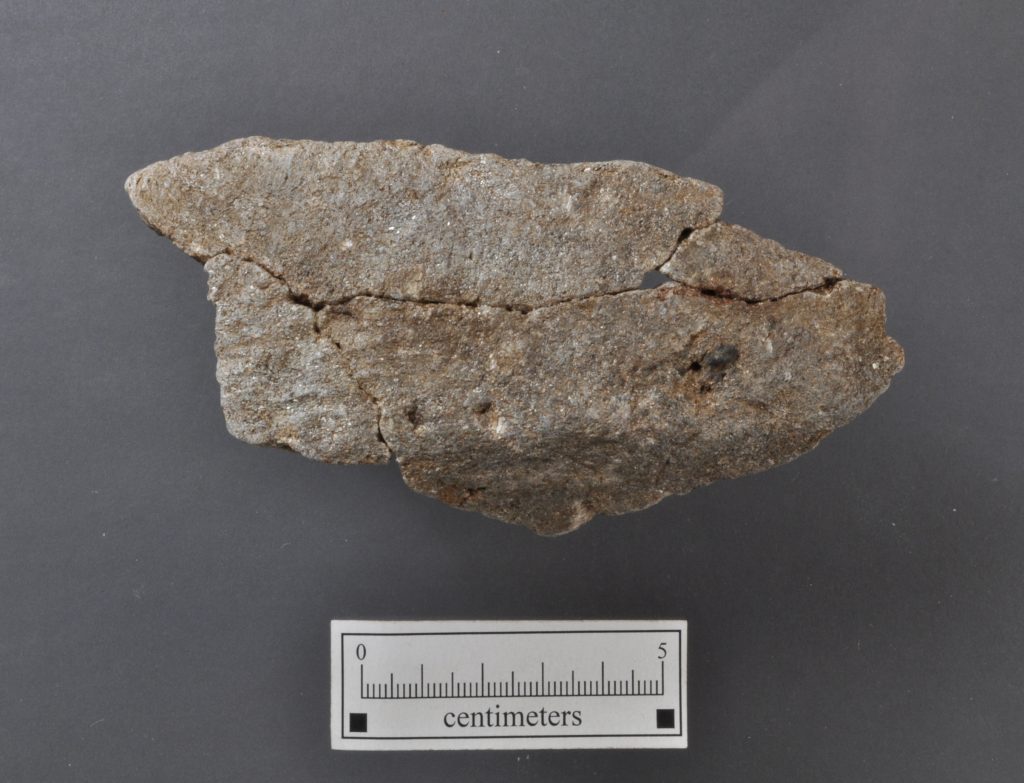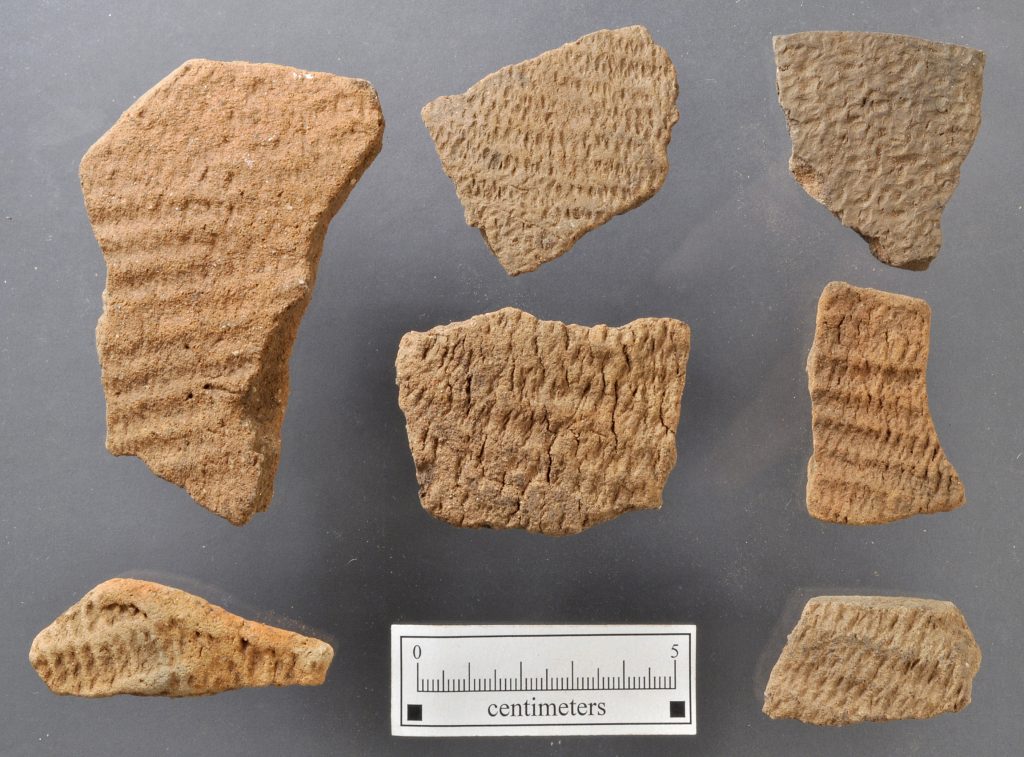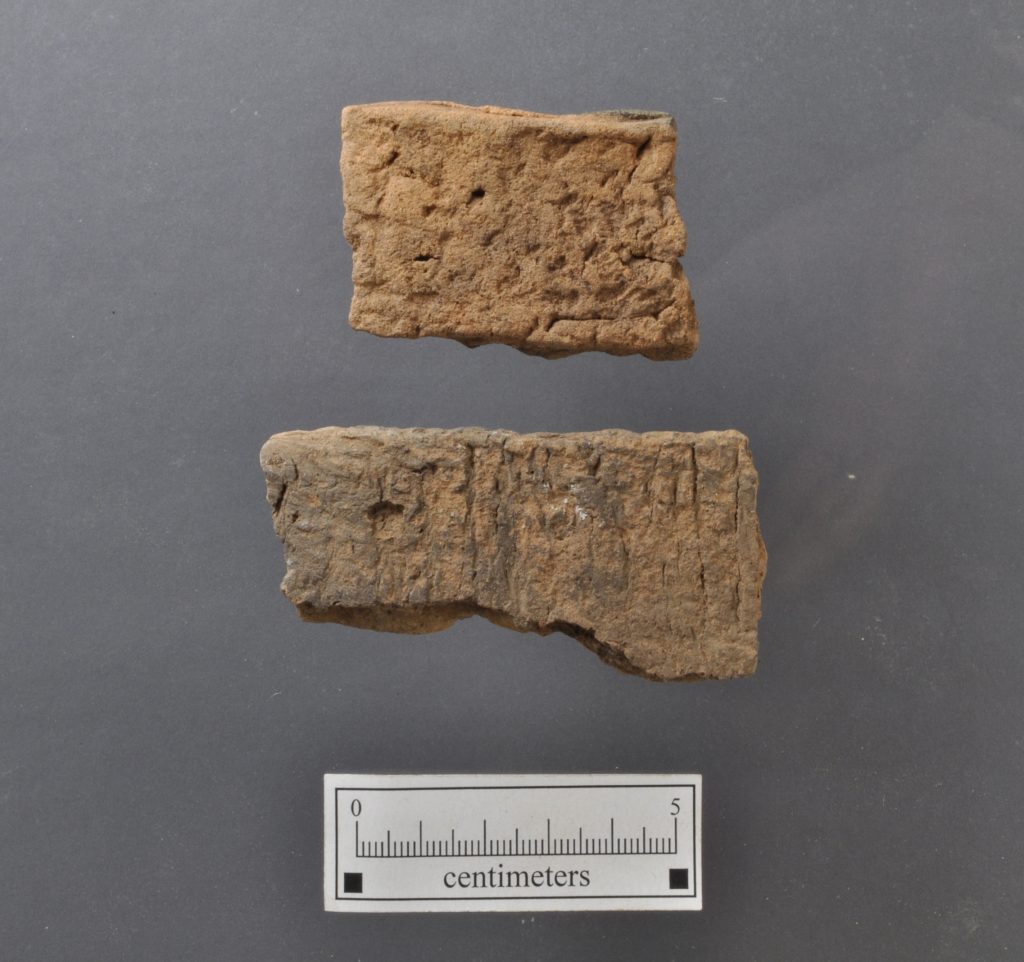Northeastern Piedmont
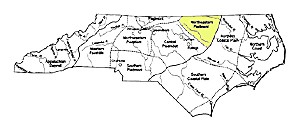 The Northeastern Piedmont is that part of the North Carolina Piedmont drained by the upper portion of the Tar River and that part of the Roanoke River that flows through the North Carolina Piedmont. During the Paleoindian, Archaic, and Early and Middle Woodland periods, the archaeology of the Northeastern Piedmont is much like the rest of the Piedmont, which is reflected in the content of the Detailed Regional Overview. After A.D. 1000 the local expression of the Piedmont Village Tradition is known from early excavations at the Roanoke Rapids Reservoir where the Late Woodland period is represented by the Gaston ceramic series.
The Northeastern Piedmont is that part of the North Carolina Piedmont drained by the upper portion of the Tar River and that part of the Roanoke River that flows through the North Carolina Piedmont. During the Paleoindian, Archaic, and Early and Middle Woodland periods, the archaeology of the Northeastern Piedmont is much like the rest of the Piedmont, which is reflected in the content of the Detailed Regional Overview. After A.D. 1000 the local expression of the Piedmont Village Tradition is known from early excavations at the Roanoke Rapids Reservoir where the Late Woodland period is represented by the Gaston ceramic series.
The Paleoindian is the time of the earliest generally accepted arrival of people in the southeastern United States – about 16,000 years ago, or 14,000 B.C. Although earlier migrations of people into the New World have been hypothesized, currently there is no firm evidence of people anywhere on the continental United States prior to 14,000 B.C.
Our level of understanding of the Paleoindian period across the state is highly uneven, due to both the history of North Carolina archaeology and environmental and geological factors.
Paleoindian Chronology
Paleoindian in the Southeast is divided into Early, Middle, and Late subperiods.
Spear points of the Early Paleoindian period (14000 – 9000 B.C.) are large, fluted lanceolates, very similar to the classic Clovis points of the West. What we know about the earliest inhabitants of North Carolina is based almost entirely on surface finds of these points. Concentrations of Early Paleoindian points have been noted in the Tennessee, Cumberland, and Ohio River valleys, as well as western South Carolina, southern Virginia, and the northern Piedmont of North Carolina.
In the Middle Paleoindian period (9000 – 8500 B.C.) the number of spear points increases considerably and regional variability in spear point forms emerge. The Cumberland, Suwanee, and Simpson point types are thought to be typical of this subperiod. One thing all have in common is a narrowing or “waisting” at the base.
The Late Paleoindian period (8500 – 7900 B.C.) shows increased population growth. Dalton points are the diagnostic Late Paleoindian point type. By the end of the Paleoindian Holocene climatic conditions prevailed and the basic hunting and gathering lifeway that persisted for the next 5000 years was set.
Paleoindian Settlement and Subsistence
Paleoindian settlers in the Southeast found a rapidly changing landscape. Current evidence suggests that many of extinctions of Late Pleistocene megafauna – including the horse, mastodon, and mammoth – were complete by 8500 B.C.
East of the Mississippi River almost no Paleoindian tools have been found with these animals. Environmental differences between the Eastern and Western parts of the continent may have necessitated very different adaptations. By the middle Paleoindian period, if not earlier, the subsistence pattern was probably very similar to that of the Early Archaic period.
Most southeastern Paleoindian sites where more than a single point has been found are related to stone-quarrying activities. This pattern reflects a generalized foraging where groups rarely engaged in subsistence activities that produced recognizable traces in the archaeological record.
Paleoindian in the Piedmont
During the full glacial period (17000 – 14500 B.C.) before Paleoindians arrived, the Piedmont had been a boreal forest. As temperatures warmed conifers were replaced by deciduous forests (oak, hickory, walnut, elm, willow, and sugar maple) by 10500 BC. Continued warming brought new forests of sweet gum, chestnut, red maple, and tupelo gum by 7000 B.C. When Paleoindians first came into the Piedmont winters were harsher and summers cooler than today. For about 1000 years, both people and now-extinct Pleistocene animals co-existed in North Carolina.
Hardaway is the most recognizable site name in North Carolina. Most stone tools found in the Piedmont are made from a fine-grained rhyolite that outcrops in the Uwharrie Mountains. Excavations at the Hardaway site in Stanly County have yielded tons of rhyolite tools and chipping debris dating to the Late Paleoindian and Early Archaic periods. The site was first recognized as important in the 1930s and excavations began after World War II.
The oldest component at Hardawaywas represented by Hardaway-Dalton points, Hardaway Side Notched, and Hardaway Blades, which date from 8500 to 7900 B.C. Other stone tools associated with the Hardaway complex, such as unifacial end scrapers and side scrapers, are very similar to those used by Paleoindians. In the Piedmont, roaming bands of hunter-gatherer Paleoindians probably enjoyed a wealth of natural resources that were exploited seasonally.
Close Paleoindian
The Archaic (8000 – 1000 B.C.) is an overarching time period covering over half of the time-span people have lived in North Carolina. This vast time has been explored by finding well-preserved deposits in rock-shelters and stratified, deeply-buried open sites in alluvial floodplains. The Archaic is generally thought of as a period dominated by nomadic, relatively small bands pursuing a hunting and gathering way of life, but there is evidence that some Archaic people settled into larger and more permanent sites relatively early.
From the coast to the mountains, the Archaic began with wandering bands of hunters and gatherers who faced a wide variety of changing environmental conditions. These bands occasionally came together at favored locations along major river valleys, but most of their time was spent in small groups scattered across the landscape foraging for food and raw materials.
Toward the end of the Archaic, large groups began to settle down and live most, if not all year in areas rich in raw material and food resources. This settled life spawned the beginnings of plant domestication and use of pottery, hallmarks of the succeeding Woodland.
The Archaic in the Piedmont
As in the preceding Paleoindian span, much more is known about the Archaic in the Piedmont than either the mountains or the coastal areas. From the 1930s through the 1960s North Carolina sites in the Piedmont were especially important in Archaic research of the eastern United States.
In many parts of the country Archaic research focused on rock shelters, where dry alkaline conditions helped preserve organic remains. But in North Carolina, archaeologists were able to define long chronological sequences by excavating deeply buried, stratified sites in the alluvial floodplains of the Piedmont. In early excavations at buried floodplain sites such as Doerschuk and Lowder’s Ferry along the Yadin-Pee Dee River, and at the nearby Hardaway site, the cultural sequence was established that still defines the Archaic in North Carolina and throughout much of the eastern United States.
The Early Archaic (8000 – 6000 B.C.)
The Early Archaic is generally viewed as the period when native populations began to adapt to an environment created by Holocene climatic conditions – conditions very similar to those of today. The Early Archaic in the Piedmont has been divided into two parts, the Palmer phase (8000 – 7000 B.C.) and the Kirk phase (7000 – 6000 B.C.).
Available subsistence information suggests that Early Archaic plant food collection focused on hickory nuts and acorns. Archaeologists presume that white-tailed deer provided the main source of meat. A dramatic increase in Early Archaic sites across the state suggests an increase in the overall population. Although subsistence strategies on the Piedmont changed little from those of the Late Paleoindian period, Early Archaic tool kits did change. New ways of attaching spears resulted in marked changes in the way points were made.
During the Palmer phase (8000 – 7000 B.C.) small, well-made end scrapers characteristic of the Late Paleoindian period continued to be made. During the Kirk phase (7000 – 6000 B.C.) scrapers were cruder and varied greatly in size and form. Adzes, gravers, drills, and perforators were made for working wood, hides, and animal bones into tools and ornaments. Cobbles were used as hammers and anvils to fashion other tools or crush and grind plant and animal resources. Groundstone tools are rare during the Early Archaic.
Early Archaic inhabitants were organized into small mobile bands (probably numbering 50 – 150 individuals). The North Carolina Piedmont offered a cornucopia of plant and animal foods, so the distribution of food resources may not have determined band territories. Some researchers believe Early Archaic bands ranged over entire drainage systems, while others believe that band territories were related to important stone resources and thus overlapped drainages.
Middle Archaic (6000 – 3000 B.C.)
During the Middle Archaic small kin-based groups moved from place to place pursuing a foraging subsistence strategy. The Middle Archaic in the Piedmont has been divided into three phases of about 1000 years each: Stanly, Morrow Mountain, and Guilford.
Simple but ubiquitous Middle Archaic tool assemblages suggest that new settlement and subsistence patterns (small, kin-related groups moving as units from place to place) formed as a response to climatic changes. This foraging pattern allowed groups to move more easily among the patchy, less predictable resources created under the warmer and drier conditions of the Middle Archaic.
Divisions of the Middle Archaic in the Piedmont are based on distinctive styles of spear points originally identified at Lowder’s Ferry and Doerschuk, sites in Stanly and Montgomery counties respectively. Deeply buried archaeological deposits at these sites, and at the Gaston site in Halifax County, show cultural continuities through the Middle Archaic.
Evidence for use of the atlatl, or spear-thrower, is first seen during the Stanly phase. Crude chipped-stone axes with lateral hafting notches have been recovered with Guilford points at the Gaston site. Other than these two innovations, there does not appear to be much that stands out about Middle Archaic tool assemblages.
Middle Archaic sites are numerous and appear to represent mostly temporary encampments. They occur across the Piedmont landscape without any obvious preference for particular environmental niches.
Late Archaic (3000 – 1000 B.C.)
In the Late Archaic, climatic conditions improved and there was a gradual trend towards more sedentary life. In the North Carolina Piedmont, it is difficult to walk over any plowed field with a nearby source of water and not find evidence of a Late Archaic campsite.
Although Late Archaic sites are numerous in the Piedmont, the full spectrum of Late Archaic culture is not found here. Large shell middens with cooking hearths, sand floors, and human and dog burials are found along the Atlantic coast. These vigorous, socially complex, semipermanent settlements are unlike any before. Similar sites are found along the broad shoals of the Savannah, Tennessee, and Green Rivers in Georgia, Alabama, Tennessee, and Kentucky. It is at sites like these that pottery first appeared and native plants were gradually domesticated.
During the Late Archaic period, people living along the south Atlantic coast from Florida to North Carolina had begun to make fiber-tempered pottery. Stalling series pottery, made by molding lumps of clay and fibrous material into simple vessel forms, was made as early as 2500 B.C. By the beginning of the Woodland in North Carolina, several different ceramic traditions had been established across the state.
The most characteristic artifact of the Late Archaic period is a large, broad-bladed point with a square stem, called Savannah River Stemmed. Savannah River points indicate the Late Archaic period from New York to Florida. Late Archaic peoples also used hammerstones to peck and grind hard rocks into axes with grooves for hafting. They also made a variety of scrapers, drills, and other chipped-stone tools, as well as polished stone weights for atlatls.
During the latter half of the Late Archaic period, hemispherical bowls were pecked and carved from soapstone. Along the coasts of Florida and South Carolina, the first pottery vessels were invented at the end of the Late Archaic period.
Seeds and nuts were ground with stone mortars, and the use of fish nets is attested by notched stone pebbles that served as netsinkers. Squash and gourds were cultivated as early as the third millennium B.C. and, by the end of the Late Archaic period, sunflower, maygrass, and chenopodium were harvested as a precursor to active cultivation.
Close Archaic
Three interrelated innovations marked the end of the Archaic and the beginning of the Woodland: pottery-making, semi-sedentary villages, and horticulture. All had their origins in the Archaic but became the norm during Woodland times.
The widespread appearance of pottery-making is viewed as going hand in hand with an increasing reliance on seed crops and more permanent settlement. Domestication of early cultigens laid the groundwork for later acceptance of tropical cultigens. Corn was not widely grown until after A.D. 700 and did not become an important food crop in many areas until after A.D. 1000. With the introduction of beans around A.D. 1200, the eastern agricultural triad of corn, beans, and squash was completed.
In North Carolina, the Woodland is divided into Early, Middle, and Late periods. Along the coast and through much of the Piedmont, the Late Woodland continues until Contact, while in the Appalachian Summit, Western Foothills, and the Southern Piedmont, Mississippian and Mississippian-influenced societies developed after A.D. 1000.
The Woodland cultures of the North Carolina Piedmont were only marginally influenced by cultural traditions elsewhere in the eastern United States. The rich and elaborate Hopewell and Swift Creek cultures that influenced wide areas of the Southeast had little impact on cultural developments in the Piedmont. And the powerful Mississippian chiefdoms that later dominate most of the Southeast were only able to penetrate the southern fringe of the Piedmont.
Piedmont Tradition Early and Middle Woodland Periods (1000 B.C. – A.D. 800)
Although we know relatively little about their origins during the Early Woodland period, cultures throughout most of the Piedmont steadily evolved along an unbroken continuum from about A.D. 1000 until the time of first contacts with Europeans. Subsistence seems to have remained evenly balanced between crop production and wild plant and animal resources. Social distinctions were based primarily on age and sex. Egalitarian Woodland societies were woven together by kinship and leadership roles were achieved rather than ascribed.
Only in the southern Piedmont is the Piedmont Village Tradition broken by the spread of the South Appalachian Mississippian tradition into the Yadkin-Pee Dee River Valley.
The stratigraphic and stylistic relationships among various ceramic types during the first half of the Woodland period are still unclear. Badin, Yadkin, Vincent, and Clements series ceramics are guides to occupations of the Piedmont during this time.
Aquatic resources are important during this time and a wide variety of mammals and birds were eaten. Several species of weedy plants, including maygrass, knotweed, goosefoot, and sunflower, although no direct evidence of these practices have yet been found in the Piedmont.
During this time the bow and arrow completely replaces the atlatl.
Early Excavations in the Northeastern Piedmont
In the Roanoke Rapids Reservoir in the Northeastern Piedmont, extensive excavations at the Gaston and Thelma sites found a broad range of Middle Woodland artifacts and numerous archaeological features.
At the Gaston site were pits containing human and dog burials. The human remains, with one exception, were tightly flexed and placed in simple oval pits. Only one burial contained an associated artifact – an engraved stone pipe made from chlorite.
Three primary ceramic traditions were found at the Gaston site: Vincent, Clements, and Gaston. Vincent pottery was near the bottom of the midden, whereas Gaston was concentrated near the top. Clements sherds appeared to be scattered throughout the midden. Vincent and Clements ceramics were assigned to the Early and Middle Woodland periods, whereas Gaston pottery was thought to have been made as late as A.D. 1700.
Vincent pottery consists of bowls and jars with straight to slightly flaring, undecorated rims. Bases are usually pointed, but sometimes rounded. Clements pottery is similar, but the cord and fabric finishes on Clements pottery are finer and vessel walls are thinner.
The Vincent ceramic complex probably overlaps with the first half of the Yadkin phase in the Southern Piedmont. The Clements Phase probably dates to the end of the Middle Woodland period.
Small, stemmed “Thelma” points showing continuity with Late Archaic points were sometimes found with the Vincent ceramics. Otherwise, large and small triangular points were generally associated with Early and Middle Woodland materials in the Roanoke Rapids Reservoir.
Piedmont Tradition Late Woodland Period (A.D. 800 – 1600)
The Late Woodland across the Piedmont begins with the Uwharrie phase. After A.D. 1100, major cultural changes took place as regional manifestations of the Piedmont Village Tradition emerged. The local expression of the Piedmont Village Tradition in the Northeastern Piedmont is the Gaston Phase.
Cultures throughout most of the Piedmont steadily evolved along an unbroken continuum from about A.D. 1000 until the time of first contacts with Europeans. Subsistence seems to have remained evenly balanced between crop production and wild plant and animal resources. Social distinctions were based primarily on age and sex. Egalitarian Woodland societies were woven together by kinship and leadership roles were achieved rather than ascribed.
Even though there were no sharp breaks or glaring innovations with the beginning of the Late Woodland period in Piedmont North Carolina, major cultural changes took place between A.D. 1100 and 1600 as regional manifestations of the Piedmont Village Tradition emerged. This was a time of population consolidation and the beginning of intertribal conflicts. In much, but not all, of the Piedmont, larger villages surrounded by stockades protected inhabitants. This was probably the result of increased agricultural production and efficiency, and competition for good agricultural lands.
Establishing linkages between archaeological complexes and specific tribal groups is often difficult and sometimes impossible. There is, however, a marked increase in the diversity of the archaeological record throughout the Piedmont during the latter half of the Late Woodland period. Much of that diversity no doubt coincides with ethnic and tribal differences taking shape at this time. The Dan River and Saratown phases probably represent people ancestral to the Sara Indians. Along the Eno River, Hillsboro phase may be related to the Eno, Shakori, and Occaneechi tribes. Further south, in the Haw River, the Haw River, Hillsboro, and Mitchum phases are possibly linked to the Sissipahaw Indians. The Gaston phase may represent the ancestors of the Occaneechis, Tutelos, and Saponis.
The Southern Piedmont saw the arrival of the Pee Dee culture – mound builders with a highly stratified and politically complex society. Pee Dee culture shares more traits with the Pisgah phase of Appalachian Summit than the Siouan cultures of the Piedmont. Both were part of the South Appalachian Mississippian cultural tradition.
Uwharrie Phase (A.D. 800-1200)
Although named for the Southern Piedmont, Uwharrie Phase sites are distributed throughout central North Carolina. Uwharrie phase is the “mother” of all succeeding phases of the Piedmont Village Tradition.
The relatively small Uwharrie villages are more sedentary than during the preceding Woodland periods. Increased reliance on domesticated plant foods is reflected in the archaeobotanical record, the large subterranean storage facilities, and the phase’s typical large conical jars.
Hunting, gathering, and fishing were still the mainstays of Uwharrie subsistence, but garden crops, including corn, became important, particularly towards the end of the Uwharrie phase.
Uwharrie pottery continued in the same basic tradition as the Badin, Yadkin, Vincent, and Clements styles, although vessel surfaces were finished with a coarse, net-like material and Uwharrie potters began to decorate their pots with crudely incised parallel lines.
Burials, placed in simple oval pits, were sometimes adorned with shell beads and other ornaments, and placed in cemetery-like areas away from the main habitation area.
From this widespread pattern of Uwharrie adaptation emerged the riverine-focused, nucleated settlements that characterized the last half of the Piedmont Village Tradition.
Close Woodland
The time of contact between Indians living in North Carolina and Europeans arriving from Spain and England varied considerably across the state. The expedition of Hernando de Soto passed through western North Carolina in the spring of 1540. Pardo’s expeditions into the same areas came less than 30 years later. The first English attempts at settlement in northeastern North Carolina came about 20 years after that, starting in 1584. But it was not until after about 1650, when English explorers, traders, and settlers came from Tidewater Virginia, that North Carolina’s Indians felt the brunt of the European presence on their land.
Accordingly, the beginnings of these arrivals do not necessarily herald the beginnings of significant changes in the histories of North Carolina’s tribes. Overall, however, this was a time of sweeping and often devastating change.
Contact, Interaction, and Cultural Change in the Piedmont
Between 1936 and 1941 the University of North Carolina’s first Siouan Project searched the Piedmont hoping to locate and identify historic Siouan villages described in the 17th and 18th century. Results were inconclusive. A return to this research four decades later, under UNC’s second Siouan Project, had much better success in exploring the question of what happened to the state’s native inhabitants as European explorers, traders, and settlers moved into the North Carolina backcountry during the last half of the seventeenth century and early eighteenth century.
Specifically, the second Siouan Project defined five Contact Period phases in the Central and North-Central Piedmont.
CENTRAL PIEDMONT:
Mitchum phase (1600 – 1670); Jenrette phase (1600 – 1680); and Fredricks phase (1680-1710).
NORTH-CENTRAL PIEDMONT:
Middle Saratown phase (1620 – 1670); and Late Saratown phase (1670 – 1710).
This success finding historically documented villages in the North-Central Piedmont has allowed development of a detailed cultural chronology allowing archaeologists to study processes of cultural change during Contact.
Trade
In the timespan from A.D. 1600 to 1670, only a few glass and brass/copper beads found their way into the Piedmont villages. These items were exchanged through native intermediaries operating the traditional trade networks. During the 1670s, however, trade changed dramatically as Virginia traders began making regular trips into the backcountry searching for new markets.
The intensification and spread of the peltry trade is directly reflected in sites of the 1670 to 1710 period (the Late Saratown and Fredricks phases). Literally thousands of beads and other ornaments, but few tools and weapons, moved into the Sara sites on the upper Dan River, while guns, knives, hatchets, beads, and trinkets were obtained in quantity by the central Piedmont Occaneechi, who controlled the flow of goods to the more remote Sara. After 1680, with the Occaneechi stranglehold broken, the Sara gained access to weapons and other tools.
European tools and ornaments were used alongside of their counterparts made with traditional technologies, rather than replacing them. But the flow of goods had a greater impact on social structure. Whereas authority and prestige had been accorded primarily to women in the earlier seventeenth century, men’s routes to status were enhanced when trade in European goods greatly increased.
Intertribal Relations
Intertribal conflict and warfare certainly preceded the arrival of Europeans. However, hostilities increased dramatically when Indian slaves and deerskins could be traded for the kettles and guns of the Europeans. Bones scarred by scalping and bullets are clear evidence of hostilities. Conflicts often took the form of raids from as far away as New York and Pennsylvania.
Whereas in the past blood feuds and revenge fueled the fires of conflict, new motives and new ways of conducting warfare were introduced. Unprecedented opportunities to exert economic and political power were available by controlling the flow of trade and acquiring weapons.
Subsistence
Archaeological evidence has shown that the new plants and animals brought by Europeans were virtually ignored by most Piedmont Indians during the Contact Period. Peaches and watermelons were widely planted, often reaching native communities well in advance of the Europeans themselves, but the traditional trinity of native crops (corn, beans, and squash) remained the mainstay. Likewise Old World animals were seldom raised.
As was the case with tools and trinkets, only those items that did not require a re-organization of the traditional ways of doing things were incorporated, and these were used alongside of, not in place of, familiar resources.
Disease
Without a doubt, the most devastating result of the European arrival on the North Carolina Piedmont was the introduction of new diseases for which the native populations had little or no resistance. Smallpox, measles, and other viral diseases swept the region, killing and disabling thousands. The devastation was accelerated during the late 1600s by increased population movements and expanded intertribal contact as native people adapted to the economic and political changes brought about by the trade.
Spread of Old World diseases depended on a number of local and regional factors. Population density, community size, and degree of contacts all affected the timing, speed, and scope of disease events.
In the North-Central Piedmont of North Carolina, there is no evidence of epidemic diseases until the arrival of Virginia traders in the second half of the seventeenth century. Only in the Late Saratown and Fredricks phases is there evidence of diseases in the form of dramatic increases in the numbers of graves and changes in burial practices.
Despite this devastation, North Carolina today is the home of the largest Native American population east of the Mississippi River. The robust cultural diversity seen in the archaeological record of the last 12,000 years survives today in the tribal traditions of North Carolina’s native peoples.
Close Historic
- Pottery fragments from a rockshelter in Granville Co., NC
- Pottery fragments from a rockshelter in Granville Co., NC
- Fabric impressed pottery fragments from Lake Gaston in Warren Co., NC
- Fabric impressed and cord marked pottery fragments from Lake Gaston in Warren Co., NC
- Cord marked pottery fragments from Lake Gaston in Warren Co., NC
- Bone awl from Lake Gaston in Warren Co., NC
- Stone pendant from the Eaton Ferry site in Warren Co., NC
- Soapstone pot fragment from the Eaton Ferry site in Warren Co., NC
- Gaston Simple Stamped pottery fragments from the Eaton Ferry site in Warren Co., NC
- Fabric impressed pottery fragments from the Eaton Ferry site in Warren Co., NC
- Cord marked and net impressed pottery fragments from the Eaton Ferry site in Warren Co., NC
- Cord marked pottery fragments from the Eaton Ferry site in Warren Co., NC

